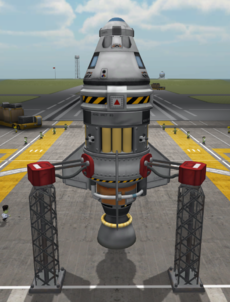Difference between revisions of "Rocket"
(first draft) |
(+standard flight profile; +TWR is important; +comparison of the (dis)advantages;) |
||
| Line 4: | Line 4: | ||
A '''rocket''' is a vertical launched [[craft]]. Usually it uses [[rocket engine]]s to propel it forward and doesn't utilise the lift of [[wing]]s or [[winglet]]s. If any it only uses [[control surface]]s to help steering in an [[atmosphere]]. The main purpose of a rocket is to reach space and an [[orbit]] or at least a sub-orbital flight. | A '''rocket''' is a vertical launched [[craft]]. Usually it uses [[rocket engine]]s to propel it forward and doesn't utilise the lift of [[wing]]s or [[winglet]]s. If any it only uses [[control surface]]s to help steering in an [[atmosphere]]. The main purpose of a rocket is to reach space and an [[orbit]] or at least a sub-orbital flight. | ||
| − | With various [[stage]]s rockets can dump dry mass and get more efficient, while a [[plane]] usually doesn't stage. | + | With various [[stage]]s rockets can dump dry mass and get more efficient, while a [[plane]] usually doesn't stage. As they don't use lift to maintain altitude, the rocket engines need to counteract the gravity. To determine if the rocket can lift of, the [[thrust-to-weight ratio]] can be determined. If the ratio is above one, the thrust generated by the engines is higher than the gravitational force and thus the rocket starts lifting off. Because the engines drain fuel, the craft gets lighter so the ratio also increases with the flight. |
| + | |||
| + | Because rockets don't need lift surface, they work in every environment and don't need an atmosphere. But on the other hand rocket engines with sufficient thrust are far more inefficient than [[jet engine]]s with similar thrust. | ||
Rockets are build in the [[Vehicle Assembly Building]] and then launched on the [[launch pad]]. | Rockets are build in the [[Vehicle Assembly Building]] and then launched on the [[launch pad]]. | ||
| + | |||
| + | == Start == | ||
| + | The usual flight profile starts on the launch pad on [[Kerbin]]. Prior to lift off the jet engines, if any, need to be started to run at full throttle on lift up. When the jet engines are running on full power, the lift off can be initiated with starting the rocket engines and releasing the [[TT18-A Launch Stability Enhancer]]s. | ||
| + | |||
| + | The rocket then starts to rise and continues so until reaching about 10 km. At this point the [[gravity turn]] is initiated by tilting to the east usually. Depending on the targeted inclination the direction of tilting might be different. For example retrograde orbits, where the crafts rotates in the other direction than the body beneath it, the tilt would be to the west. With the gravity turn the craft starts to pick up horizontal velocity which is crucial for an stable [[orbit]]. The engines continuing to accelerate the vessel to raise the apoapsis and periapsis out of the atmosphere. | ||
| + | |||
| + | As soon as the apoapsis and periapsis are outside the atmosphere, the craft won't fall back and reached a so called parking orbit. From this orbit it is possible with orbital maneuvers like the Hohmann transfer, to change the orbital shape. | ||
[[Category:Craft]] | [[Category:Craft]] | ||
Revision as of 09:59, 28 August 2013


A rocket is a vertical launched craft. Usually it uses rocket engines to propel it forward and doesn't utilise the lift of wings or winglets. If any it only uses control surfaces to help steering in an atmosphere. The main purpose of a rocket is to reach space and an orbit or at least a sub-orbital flight.
With various stages rockets can dump dry mass and get more efficient, while a plane usually doesn't stage. As they don't use lift to maintain altitude, the rocket engines need to counteract the gravity. To determine if the rocket can lift of, the thrust-to-weight ratio can be determined. If the ratio is above one, the thrust generated by the engines is higher than the gravitational force and thus the rocket starts lifting off. Because the engines drain fuel, the craft gets lighter so the ratio also increases with the flight.
Because rockets don't need lift surface, they work in every environment and don't need an atmosphere. But on the other hand rocket engines with sufficient thrust are far more inefficient than jet engines with similar thrust.
Rockets are build in the Vehicle Assembly Building and then launched on the launch pad.
Start
The usual flight profile starts on the launch pad on Kerbin. Prior to lift off the jet engines, if any, need to be started to run at full throttle on lift up. When the jet engines are running on full power, the lift off can be initiated with starting the rocket engines and releasing the TT18-A Launch Stability Enhancers.
The rocket then starts to rise and continues so until reaching about 10 km. At this point the gravity turn is initiated by tilting to the east usually. Depending on the targeted inclination the direction of tilting might be different. For example retrograde orbits, where the crafts rotates in the other direction than the body beneath it, the tilt would be to the west. With the gravity turn the craft starts to pick up horizontal velocity which is crucial for an stable orbit. The engines continuing to accelerate the vessel to raise the apoapsis and periapsis out of the atmosphere.
As soon as the apoapsis and periapsis are outside the atmosphere, the craft won't fall back and reached a so called parking orbit. From this orbit it is possible with orbital maneuvers like the Hohmann transfer, to change the orbital shape.